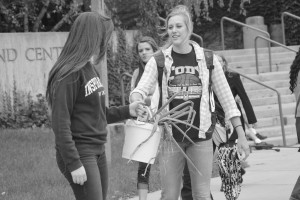Gustavus Adolphus College has recently started composting organic waste on campus in another leap toward systematic sustainability. The composter was installed in late June between Big Hill Farm and Physical Plant.
Measuring about 24 feet long and 8 feet wide, it has an augur that will mix food waste at one end that will shuffle the contents around. The building will store the compost as well as waste if needed. Future plans include the addition of a greenhouse to the side of the building.

The Close The Loop Compost Relay was held during Daily Sabbath time on Friday, Sept. 20. Nearly 200 people attended the event, creating a human chain from the Dining Services Landing Dock all the way to the food composter located near Physical Plant. Buckets of fresh vegetables were passed from Big Hill Farm to the Caf along the human chain, and pails holding food waste were then passed from Dining Services to the composter back through the line, thus symbolically “closing the loop” on the food cycle.
Chaplains Brian Konkol and Siri Erickson kicked off the event with a short speech and a prayer.
“It’s really great to have this opportunity, thinking about our responsibility not only to one another as human beings, but also our responsibility to the Earth. This is a practical way for us to recognize our love of the earth, our care for the earth, and the responsibility we have for the earth,” Konkol said.
Jim Dontje, Director of the Johnson Center for Environmental Innovation, who worked on the composting project, then spoke to the crowd. He spoke of past students and the Director of Dining Services, Steve Kjellgren’s desire for composting to take place at Gustavus and the process of getting it going. The composter proposal was originally brought to the attention of Student Senate in 2010 and a resolution was decided on. Unfortunately, it was not carried out. However, after receiving funding shortly afterward, a plan for composting was set.
“Fortunately for us, we were given some generous funding from The Margaret A. Cargill Foundation with the designation to apply it to special environmental projects, and one of the projects the environmental studies chose was food composting, and what you see here today is a result of that chain of events,” Dontje explained.
According to Dontje, various members of Kjellgren’s staff attended composting school this past summer to prepare for the development. Members of the Big Hill Farm staff collaborated on the project as well.
“[The Big Hill Farm staff] have done a very fine job of getting us off of the ground,” Dontje said.
Johnson Center for Environmental Innovation and the Arboretum student worker Sam Warburton has participated in the planning process of the composter. He has interned at Big Hill Farm since March 2012.
“[With regards to the composter, the Big Hill Farm] interns last year were invited to be a part of the decision-making. We were given access to offers from different companies,” Warburton said.
Warburton was at the Close the Loop Compost Relay event helping participants prepare.
“My hope is that the new composter will expand the minds of students as to how we may be able to transform our everyday lives into ones that support a more sustainable campus. The waste we produce will contribute to making Big Hill and other campus gardens even more productive by recycling waste and turning it into food,” Warburton said.